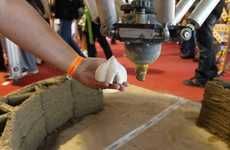
The World's Smallest Magazine Cover Was Created by IBM 3D
Jennifer Paul — April 28, 2014 — Tech
The world's smallest magazine cover has been printed in 3D. IBM's microscopic 3D Printer now holds the title of printing the smallest magazine cover in the world. IBM and National Geographic Kids revealed the cover that is small enough to fit on a single grain of salt 2,000 times.
This has been claimed the world's smallest magazine cover by The Guinness Book of World Records. The gray-scaled version of the NatGeo Kids' cover is invisible to the naked eye. Dr. Colin Rawlings is a physicist at IBM Research and he said that even if you had a microscope, you would only be able to see a very blurry version. If you want to see the world's smallest magazine cover in its full form, you would need an electron microscope.
This has been claimed the world's smallest magazine cover by The Guinness Book of World Records. The gray-scaled version of the NatGeo Kids' cover is invisible to the naked eye. Dr. Colin Rawlings is a physicist at IBM Research and he said that even if you had a microscope, you would only be able to see a very blurry version. If you want to see the world's smallest magazine cover in its full form, you would need an electron microscope.
Trend Themes
1. Micro-3d Printing - The development of 3D printing technology for creating microscopic objects presents opportunities for industries such as medical devices and electronics.
2. Nanotechnology Design - The creation of microscopic designs using 3D printing technology can revolutionize the fields of nanotechnology and microelectronics.
3. Precision Manufacturing - The use of 3D printing for creating incredibly precise parts can provide opportunities to industries such as aerospace and automotive manufacturing.
Industry Implications
1. Medical Devices - The ability to create small and intricate parts using 3D printing could revolutionize the medical device industry, allowing for the creation of customized devices that are specific to individual patients.
2. Microelectronics - The ability to create complex designs at a microscopic level using 3D printing could lead to breakthroughs in microelectronics and photonics, allowing for the development of more powerful and efficient devices.
3. Aerospace Manufacturing - The use of 3D printing for creating precise and lightweight parts could provide opportunities for the aerospace industry, such as reducing the weight of aircraft components and improving fuel efficiency.
0.8
Score
Popularity
Activity
Freshness















